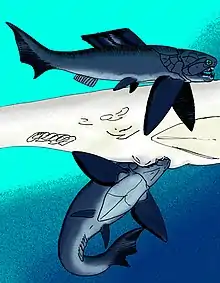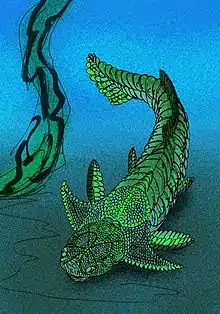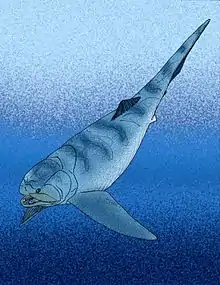Dinichthys
Dinichthys herzeri is an extinct, giant, marine arthrodire placoderm from the Late Devonian (Famennian stage) of Ohio and Tennessee. It was comparable in size, shape, and ecological role to the better-known Dunkleosteus. Originally described in 1868 by John Newberry on the basis of an incomplete skull roof and mandibles (AMNH 81), this species remains imperfectly known to this day.
| Dinichthys | |
|---|---|
 | |
| Reconstruction | |
| Scientific classification | |
| Kingdom: | Animalia |
| Phylum: | Chordata |
| Class: | †Placodermi |
| Order: | †Arthrodira |
| Superfamily: | †Dinichthyloidea |
| Family: | †Dinichthyidae Newberry, 1868 |
| Genus: | †Dinichthys Newberry, 1868 |
| Species: | †D. herzeri |
| Binomial name | |
| †Dinichthys herzeri Newberry, 1868 | |
| Synonyms | |
|
Ponerichthys Miller, 1892 | |
For much of the 20th century, many unrelated large arthrodires were classified together within this genus, including species now assigned to Dunkleosteus, Eastmanosteus, and Titanichthys. Today, Dinichthys is considered a monotypic genus, containing only the type species, D. herzeri. Similarly, in a 2010 analysis, the family Dinichthyidae that once held a wide range of arthrodire genera was redefined as comprising only Dinichthys.[1]
The type species of Dunkleosteus was originally described as Dinichthys terrelli by Newberry in 1873. After complete exoskeletons of this species were discovered in the early 20th century,[2] Din. terrelli served as the basis for life reconstructions of the genus as opposed to the fragmentary Din. herzeri, even long after terrelli was separated into Dunkleosteus by Jean Pierre Lehman in 1956. As a result, most illustrations captioned as Dinichthys are actually pictures of Dunkleosteus.[3]
References
- Carr R. K., Hlavin V. J. (2010). "Two new species of Dunkleosteus Lehman, 1956, from the Ohio Shale Formation (USA, Famennian) and the Kettle Point Formation (Canada, Upper Devonian), and a cladistic analysis of the Eubrachythoraci (Placodermi, Arthrodira)". Zoological Journal of the Linnean Society. 159 (1): 195–222. doi:10.1111/j.1096-3642.2009.00578.x.
- Branson, E. B (1908). "Notes on Dinichthys terrelli with a restoration" (PDF). The Ohio Naturalist. 8 (8): 363–369. hdl:1811/1611. Retrieved 2012-10-30.


